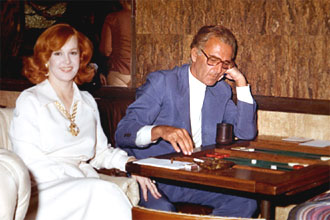|
| Magriel's NYT Columns |

Lona and Tim Holland. Holland’s backgammon
books were dedicated to wife Lona. To celebrate its official opening last Tuesday, the Park 65 Backgammon Club held a gala cocktail party with Tim Holland, the club’s president, as host. This attractive private club, in the Mayfair House Hotel at 65th Street and Park Avenue, has a select membership of backgammon devotees. Holland, who conceived the idea of Park 65, is one of the outstanding names in backgammon.
In the late 1960’s, he dominated international competition. He won the World Championship in 1969, 1970, and 1971, the first years that the tournament was held. He is also well known as the author of three books on the game. Although in recent years Holland has not actively pursued the professional backgammon circuit, he still excels at this game and many others. He is an accomplished bridge player and one of the best amateur golfers in the country.
The diagrammed position is drawn from Holland’s book, “Better Backgammon.”
|
| Black to play 4-1. |
The alert player may notice that 18/13 leaves Black exposed to being hit by 6-6. This player might move 18/14, 3/2, avoiding any possibility of being hit by White next roll.
Holland points out that 18/13 is nevertheless the correct play; if White rolls 6-6, Black actually wants to be hit! Let’s see what happens either way after White rolls double 6’s.
If Black plays 18/14, 3/2 and White rolls 6-6, White will sweep around the board, missing Black, and take a man off. Black will then have virtually no chance — he will be hopelessly behind in the race, with White about to redouble.
On the other hand, if Black plays 18/13 and White rolls 6-6, White will be forced to hit Black on the 13-point, continue on to the 19-point, and bear off the same man. Black, from the bar, will now have a direct shot back at White’s exposed man on the 20-point. By hitting, Black will be a strong favorite to win.
|
Black plays 18/14, 3/2. |
Black plays 18/13. |
Rollout
 Tom Keith 2013 |
|
Money play White owns 2-cube Black rolls 4-1 1296 games with VR Checker play: 2-ply Cube play: 3-ply Red |
| 4-1: | Game | G | BG | Equity | ||||
| 1 | 18/14, 3/2 |
W L |
.7415 .2585 |
.0198 .0020 |
.0003 .0000 | +0.4217 |

| |
| 2 | 18/13 |
W L |
.7426 .2574 |
.0187 .0029 |
.0004 .0000 | +0.4174 | (0.0043) | (a) |

|
|

